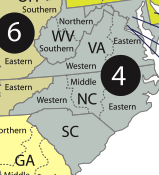Is the 4th Circuit veering back to the center?

By Sharon McCloskey, NC Policy Watch
It's been nearly a decade since the New York Times profiled the 4th U.S. Circuit Court of Appeals in Richmond -- the court of last resort for the vast majority of cases filed in federal courts in North Carolina, South Carolina, Maryland, Virginia and West Virginia -- as "the most aggressively conservative federal appeals court in the nation."
It was a court shaped largely by the patronage and obstructionist tactics of Carolina senators Strom Thurmond and Jesse Helms, then consisting of eight Republican and four Democratic appointees.
And it was not just conservative, but boldly so, wrote Deborah Sontag in "The Power of the Fourth," a court "confident enough to strike down acts of Congress when it finds them stretching the limits of the federal government's power and hardheaded enough to rule against nearly every death-row defendant who comes before it."
Cornell law professor and renowned death penalty litigator John Blume once called the Fourth Circuit the "black hole of capital litigation," and authored a law review article about the court entitled "The Dance of Death, or 'Almost No One Gets Out of Here Alive.'"
But since late 2009, Barack Obama has appointed six judges to the Fourth Circuit, flipping the scorecard in favor of Democratic appointees.
What that has brought, in the eyes of court observers, is a slow but not yet steady shift leftward -- to the center.
Packing the court
The Lewis F. Powell, Jr. United States Courthouse, where the 4th Circuit sits, predates the Civil War -- the second oldest continuously operating courthouse in the federal system.
But its age belies the pace of proceedings inside.
Some 5,000 appeals were filed there -- and just as many resolved -- during 2011, putting the court in the middle of the pack for federal court of appeals caseloads. But it ranks near the top in terms of efficiency, second only to the 8th Circuit in moving its cases quickest from filing to disposition.
For most of those appeals, the Fourth Circuit represented the end of the line, since the nation's highest court hears only a handful of cases coming out of the federal appellate courts each year.
And for residents of the states within the circuit, the court's decisions on the wide variety issues presented in those appeals establish the law, unless and until the Supreme Court says otherwise.
In the last month alone, the Fourth Circuit handed down decisions on issues ranging from the rights of criminal defendants to multinational admiralty disputes to Medicaid fraud by drug companies -- mostly affirming decisions of the district courts, though in one recent reversal, a three-judge panel rejected a Cary, N.C. resident's claim that municipal ordinances banning his "screwed by the town of Cary" sign violated his First Amendment rights.
It heard arguments from payday lenders that claims alleging violations of North Carolina usury statutes had to be resolved by arbitration; between a North Carolina design company and a national homebuilder involving allegations of infringement of rights to architectural drawings; and from a criminal defendant confined to Butner for six years that he poses no threat to society and should be released.
The court, with a majority of Republican appointees, earned its conservative reputation by ruling over the years that women could be banned from military institutes and that the Federal Drug Administration could not regulate tobacco, and by rejecting virtually every death penalty appeal that came before it.
But a Democratic-controlled U.S. Senate rejection of Bush nominees for the court starting in 2007 left Barack Obama with four vacancies to fill when he first took office, and two more since.
Despite a sense that Obama has been slow to fill judicial vacancies during his first term, he has managed to place six new judges on the Fourth Circuit, including two African-Americans, two women and the court's first Hispanic, former North Carolina Business Court judge Albert Diaz.
Too soon to tell
Certainly the shift in party affiliation gives some comfort to those long weary of the Fourth Circuit's staunch conservatism.
"Some of this is comparative," Blume said. "There was a time, at least in the habeas context, capital and non-capital, and in the civil rights context, that it was almost impossible for a plaintiff or a petitioner to win, regardless of the merits of the claims," he added. "With the Clinton appointees and the current president's appointees there has been a shift. I don't know that I would call it a seismic shift. It's now a court before which you can get a panel and win."
Blume pointed to the court's 2-1 decision in Elmore v. Ozmint, reversing a death row defendant's murder conviction, as one example of a shift.
Richmond School of Law professor Kevin Walsh, who clerked on the court for Judge Paul Niemeyer, thinks the shift has been more dramatic. One way to see that is to look at court en banc decisions, where the full 15-member court reviews a decision by one of its three-judge panels, he told the Richmond Times Dispatch in November.
For example, in a recent appeal by military contractors seeking immunity in suits concerning the Abu Ghraib prison in Iraq, the three-judge panel -- two Republican appointees and one Democrat -- sided with the contractors. But the en banc panel then reversed, 11-3.
Walsh said that he thought that the court's judges were not necessarily voting along party lines, but along ideological divides that often correlate with those lines.
But not always. Close to a decade ago, Sontag pointed out that Judge William Traxler voted so often with the conservative majority that people forgot he was a Clinton appointee.
Whether that comfort is lasting remains to be seen, given the recency of the Obama appointments, said University of Richmond School of Law professor Carl Tobias.
"First of all, it's too early to tell," he said. "We just don't have enough decisions or enough panels on which the Obama nominees have sat yet. And I personally resist the notion that you can tell a whole lot by the appointing president. I think it depends on the issue before the court."
"For example in the environmental area there are just so few cases, or opinions that are written, there isn't enough to tell much," he added. "You have to look at it over time and over case types."
If reversal rates mean something, a liberal philosophy has yet to set in. During the 2011 term, the Fourth Circuit was the circuit least reversed by the conservative U.S. Supreme Court.
But Tobias doesn't put much credence in those either, at least not in the short term. "In any particular year, there may be so few cases reviewed that that would skew reversal rates."
In the end, he added, you have to look at the individual appointees. "Most of them were sitting judges, mainstream judges."
"I do think it’s a less conservative court -- there's no dispute about that. But whether it's liberal is much less clear."
Tags
NC Policy Watch
A project of the N.C. Justice Center, N.C. Policy Watch is a news and commentary outlet dedicated to informing the public and elected officials as they debate important issues and to improving the quality of life for all North Carolinians.
